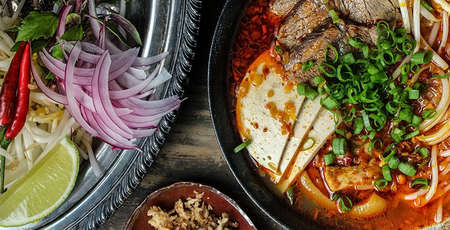
Hue royal meal - an exceptional slice of Vietnamese culinary heritage
- on Oct 2, 2019 By: Ngoc Nguyen
The heritage of Hue is not just limited to the beautiful imperial palaces and tombs constituting the imperial city of Hue recognized by UNESCO. This fame also owes to a whole series of culinary traditions inherited from the royal court of Hue. With a flourishing monarchy over more than a century of the reign of the emperors of the Nguyen dynasty, the royal cuisine is known for its exceptional refinement, ranging from preparation to tasting and through to its presentation. The culinary arts are steeped in the history and culture of the city, which helps to explain the curiosity of culture and gastronomy lovers who have a desire to visit Hue city.
While a royal meal of Hue is not far from ordinary ingredients, it is distinguished by its surprising subtlety, adherence to strict procedure and a sophisticated presentation. To every lord, every honour and dish found in the royal tables of Hue is reminiscent of a work of artistic skill. In addition, the recipes served there had to be particularly delicious while presenting important health benefits.

On the seasoning side, this stage alone deserves irreproachable attention in this regal culinary philosophy. The chef must take care to season the dish, not once as usual, but not fewer than three or even four times. Also to marinate in the beginning and ending of the preparation and the presentation of the dish. This gestural rigor aims, according to gourmets, to ensure the best flavours of the dish so it can be rightfully served to the emperors and mandarins of yesteryear.
The royal cuisine of Hue does not lack ceremony that intervenes in choices of ingredients, preparation, service, dishes, decoration etc. Speaking of the range of choice, there are between 35 and 50 different dishes in a meal of kings Minh Mang, Dong Khanh and Khai Dinh. Among the delights of the king, some use very rare ingredients. This is a collection of eight precious dishes namely peacock imperial pies, phoenix patties, rhino skin, bear's hand, sambar deer’s tendon, orangutan lip, elephant’s foot meat and swiftlet nests.
These are traditional recipes whose secrets are handed down from generation to generation, which also contain exotic flavors incorporated by foreign ambassadors.

Reconstitution of the royal meal of Hue
One can distinguish the different types of feasts corresponding to the particular occasions of the royal life, for example meals of worship for an important ceremony, reception banquet of mandarins, ambassadors, new doctors and more.
Speaking of scale, a large banquet has up to 161 dishes versus 50 for a distinguished feast. A vegetarian feast reserved for religious offerings consists of 25 dishes. The dessert alone in royal cuisine of Hue has to include 12 dishes.

At the level of style, the meal served to King Gia Long seems the most moderate while that of King Dong Khanh is so hearty with 50 dishes prepared by 50 cooks of the royal family.
Have you ever admired the elaborately carved vegetables and fruits that show the reputation of the hue peoples? The best of the best, a royal meal of Hue is deliciously enjoyed by the eyes and the nose long before the mouth.
Suffice to say that a little tour reconstituting the tables of the kings of Nguyen will help you live like a king with a unique and memorable experience. This activity is appreciated by many people in Vietnam and especially in the imperial city of Hue.
Related articles:
>> Hue Imperial city - A to Z Travel guide
Comment
Other Blog
Categories
Latest News
on 31 Dec, 2025
on 31 Dec, 2025
 Español
Español Français
Français




















Morgane Ter Cock
on Dec 18, 2025HerbertPhomaMS
on Oct 19, 2025Lilyan Cuttler
on Oct 15, 2025Avenue17XC
on Sep 14, 2025Avenue18JL
on Jul 21, 2025